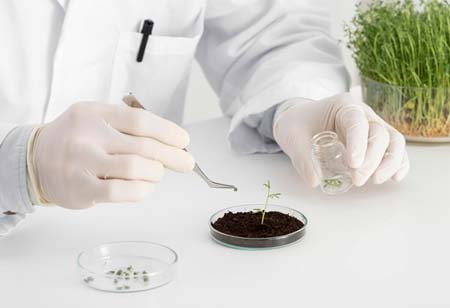Thank you for Subscribing to Agri Business Review Weekly Brief
Soil Micronutrient Analysis for Agronomic Innovation
The shift in agriculture towards micronutrient mapping highlights its importance for sustainable intensification, enabling data-driven farming and public access to vital soil health information.

By
Agri Business Review | Friday, October 31, 2025
Stay ahead of the industry with exclusive feature stories on the top companies, expert insights and the latest news delivered straight to your inbox. Subscribe today.
In the quest for sustainable agricultural intensification, the focus of agrarian science, long dominated by macronutrients like nitrogen, phosphorus, and potassium (NPK), is decisively shifting to the critical, often-overlooked role of micronutrients. Elements such as zinc, boron, iron, manganese, and copper, though required in minute quantities, are the essential catalysts for plant health, yield, and nutritional quality. Moving beyond localised soil testing, the industry is now embracing a new paradigm: micronutrient mapping as essential public infrastructure, driven by ambitious national soil health missions and enabled by the power of open data platforms.
This transformation reframes soil data not as a static report, but as a foundational utility, much like a national power grid or transportation network. When soil intelligence, particularly at the micronutrient level, is systematically collected, processed, and made universally accessible, it becomes a public good that underpins an entire sector’s efficiency, resilience, and sustainability. This infrastructure empowers a new generation of data-driven agriculture, moving from reactive problem-solving to proactive, predictive management.
National Soil Health Missions as the Data Engine
The engine driving the creation of this new infrastructure is the implementation of large-scale, state-sponsored national soil health missions. These sweeping programs represent a fundamental government commitment to cataloging the nation's primary agricultural resource. By moving from a piecemeal approach to a systematic, grid-based, or village-level soil sampling strategy, these missions generate an unprecedented volume of high-quality, standardized data.
The primary output of these missions—often materialised as soil health cards or digital reports for individual farmers—is just the beginning. The actual long-term value lies in aggregating this data. For the first time, it is possible to move from a farm-scale understanding to a regional and national one. These missions are meticulously analyzing millions of soil samples, testing not only for primary nutrients and pH but also for the status of key micronutrients.
This systematic collection establishes a national baseline —a definitive ledger of the soil's chemical and biological assets. It identifies vast regions of deficiency or toxicity that were previously invisible, allowing for strategic, large-scale interventions. This government-led, science-backed data generation is the foundational act of building the infrastructure, laying the "digital bedrock" upon which all subsequent applications are built.
Advanced Mapping as the Processing Plant
Raw soil sample data, though inherently valuable, resembles unrefined ore—it requires systematic processing, analysis, and visualization to become a functional component of agricultural infrastructure. Advanced mapping and modeling technologies perform this transformative role, acting as the “processing plant” for the vast volumes of raw data generated by national soil and agricultural missions.
At the core of this transformation lies Geographic Information Systems (GIS), which enable the georeferencing of each soil sample to integrate micronutrient information—such as zinc and boron concentrations—with other critical spatial datasets, including topography, groundwater levels, and land-use patterns. Through spatial interpolation techniques, GIS facilitates the creation of predictive, continuous maps that illustrate variations in micronutrient levels across entire landscapes, extending insights even to areas not directly sampled.
This analytical capability is further amplified by remote sensing technologies, including satellite imagery and unmanned aerial vehicles (UAVs). Equipped with multispectral and hyperspectral sensors, these platforms detect subtle variations in crop foliage that often correspond to specific nutrient deficiencies. When integrated with ground-truthed soil data, this remotely sensed information supports the development of highly accurate, large-scale models that map micronutrient status and monitor changes in near-real time. The convergence of these technologies transforms static datasets into predictive intelligence—empowering data-driven agricultural planning and sustainable land management.
Open Data Platforms as the Distribution Grid
The most transformative element of this emerging paradigm lies in its distribution network: open data platforms. If national missions serve as the engine and mapping technologies as the processing plant, then open data platforms are the grid that transmits this power to all stakeholders. By adopting an open-data philosophy, governments and research institutions are ensuring that extensive repositories of soil micronutrient information are publicly and freely accessible. This democratization of data effectively transforms information into infrastructure.
These platforms—often embodied as national soil information systems or publicly available “soil health data cubes”—cater to a wide array of users simultaneously. For farmers and agronomists, they provide direct access to high-resolution maps that inform precision nutrient management, enabling decision-support tools that recommend custom-blended nutrient formulations to optimize both yield and input efficiency. For policymakers, they function as strategic dashboards, guiding decisions on fertilizer subsidies, identifying nutritional deficiency hotspots across regions, and prioritizing public investments for maximum impact. For researchers and innovators, they offer a fertile ground for discovery—allowing scientists to model the intricate interactions between soil, climate, and crop genetics, while empowering entrepreneurs to develop novel solutions and applications built upon a dependable, open-access data foundation.
Ultimately, this open-access approach accelerates innovation and fosters equity, creating a level playing field where knowledge becomes a shared public asset. It dismantles the silos that once restricted critical data, instead transforming it into a collective resource that amplifies its value through widespread use. This evolution from data ownership to data stewardship marks the decisive step in establishing micronutrient intelligence as a genuine public utility—one capable of underpinning a resilient and food-secure future.
The revolution in micronutrient mapping is the decisive, final step toward fully integrated, sustainable agricultural intensification. By establishing open, standardized, and soil intelligence as essential public infrastructure, it shifted the focus from macronutrient quantity to micronutrient quality. This collective effort—from the national sampling missions to the open-data distribution platforms—creates a powerful, accessible tool for every farmer and policymaker. Ultimately, the systematic mapping of the soil's essential elements is about guaranteeing the nutritional richness and long-term security of the world's food supply, ensuring that the critical, minute elements required for life are no longer overlooked.
More in News





